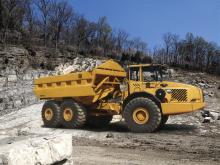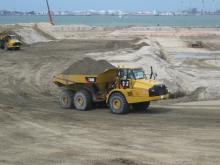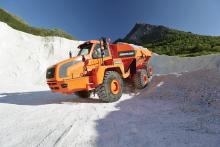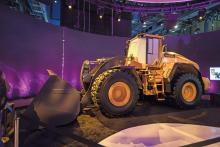
Changes in the hauling market don’t move with quite the same speed and regularity as the excavating and loading sectors, writes Dan Gilkes.
For one thing there are fewer players in the truck market and, in the Case of larger rigid trucks at least, there is not as much regulation in terms of engine emissions driving the constant upgrades that we see in smaller equipment.
What’s more, many of the larger RDTs are working in territories that do not have as tough emissions standards to comply with as European and North American customers.
That’s not to say that truck development stands still however: far from it. The articulated dump truck (ADT) sector in particular has seen a lot of activity in the past year and there will be a number of additional developments during 2014.
The biggest news in the dump truck market though doesn’t involve engine technology or individual machine specification. It is more the fact that
We have yet to see how the acquisition of Terex trucks will play out, particularly with both companies building competing ADTs, but for Volvo having a full truck range to work with its larger wheeled loaders and tracked excavators is definitely a major positive move.
Terex had most recently been working on updates to its rigid truck line, with the TR60 in particular undergoing a major overhaul last year. The 55tonne capacity truck now benefits from dual retardation systems for maximum safety and control on descending haul roads. Improvements to onboard diagnostics and centralised hydraulic test points have also increased serviceability on site, reducing downtime for quarry operators.
Whichever emission level you choose, the C15 and C18 Cat engines can both be programmed to meet specific customer efficiency goals. There are two modes available, Economy and Adaptive Economy. Economy mode lets the customer de-rate the engine output by between 0.5-15% across all sections of the haul cycle.
With Adaptive Economy mode the truck monitors demand and delivers fuel savings when possible, for instance when running unladen or downhill. However it maintains power delivery as required for laden and uphill hauling. The trucks also feature a new Auto Neutral Idle system that automatically puts the transmission into Neutral after the brake has been applied for more than 15 seconds. This AIMS to reduce parasitic driveline losses and further boost fuel economy if the driver is sitting with the truck in gear for any length of time.
The truck’s upgraded cab features a 10.1” LCD screen that doubles as both an instrument panel and a monitor for a reversing camera. Rear axle wet disc brake assemblies, which feature additional brake area for increased retardation, now incorporate an integral parking brake as well.
Hitachi can also set the EH1100-5 with a speed limiter, automatically restricting top speed on site if required by the customer.
As mentioned, there has been a lot more happening in the ADT market than with rigid truck design. While buying up the competition, Volvo has also been concentrating on its own range of articulated trucks, showing the first of the G Series range at the recent
Powered by Tier 4 Final engines, the G Series trucks have an automatic traction control system that switches from 6x4 to 6x6 drive automatically as required. All differentials can be 100% locked and Volvo’s Full Suspension system is available as an option on both the A35G FS and the A40G FS.
Caterpillar has been working on its ADTs as well as its rigid quarry trucks. The 725C and 730C are the latest models to be upgraded, gaining Tier 4 Final engines, a new six-speed powershift transmission and a new automatic traction control system.
Unlike previous models, that had a pedal on the floor of the cab to activate the differential locks, the system works completely automatically on the C Series machines, without any input from the driver.
Braking power has been greatly improved too, thanks to the adoption of an engine brake on the 730C. This brake system is said to offer up to 60% more retardation than on older models, and is capable of almost bringing the laden truck to a standstill without the operator having to use the service brakes.
The 730C can be ordered with an ejector body if preferred and both trucks can be supplied as bare chassis cabs, for use as service trucks, water spray vehicles and for waste handling and hook-lift applications.
One of the big changes for the E Series is the new cab environment, with its 10” full colour screen and automotive-style mouse interface to control the many functions of the monitor. An air-suspended seat, fully adjustable steering column and high output audio system complete the upgraded interior.
Not to be left out, Komatsu has moved to Tier 4 Final this year with its HM300 articulated hauler. The truck uses Komatsu’s own SAA6D125E-7 engine, rated at 242kW and, once again, the company is claiming fuel savings over the older model.
The HM300 comes with
Though perhaps not a big player in the quarry market, some smaller sites with poor ground conditions could find a use for the Hydrema 12tonne payload 912 dump truck.
This compact machine has recently had an engine change, from
The Hydrema has an improved engine cover that now lifts clear of the chassis for easier access to the engine and transmission. The air conditioning unit has also been moved to provide improved serviceability.
Whatever your manufacturer of choice, the seemingly unrelenting march of progress continues, resulting in improved productivity from increasingly powerful drivelines. Yet despite this boost in output, somehow manufacturers seem to be finding fuel savings and other efficiency gains that go some way to offset the premium purchase price that emissions regulation requires.
There also seems to be far greater focus on operator comfort and assistance, with continued adoption of automated control systems such as traction control and differential locks. This can only be a good thing, driving improved safety on site, reducing damage to and abuse of components, plus lowering operating costs..










